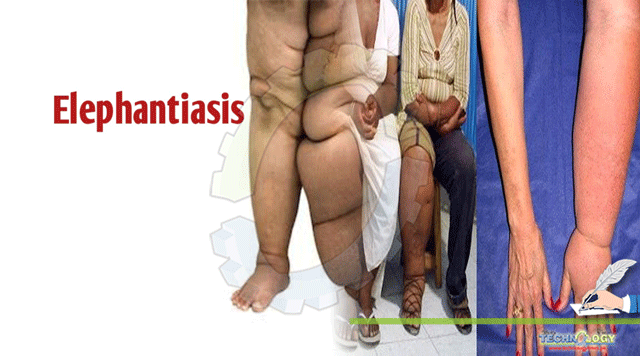Elephantiasis is the zoonotic disease cause by filarial parasites, transmitted to humans through mosquitoes and bacteria.

By Maria Kausar,Muhammad Sohail Sajid,Kashif Hussain
Abstract:
Elephantiasis is the zoonotic disease cause by filarial parasites, transmitted to humans through mosquitoes and bacteria. There are number of causative agents of elephantiasis. The main symptom of elephantiasis is gross enlargement and swelling of an area of the body because of the accumulation of fluid. The World Health Organization (WHO) estimate that 120 million people worldwide are affected by elephantiasis. Treatment for elephantiasis includes antibiotics, antiparasitic drugs and mosquito control.
Introduction:
Elephantiasis is the one of neglected tropical disease also known Lymphatic filariasis. This infection is mostly transfer by the mosquito of genus Culex, but Anopheles and Aedes mosquitos are also known to transmit elephantiasis. The causative agent of the elephantiasis are parasites and bacteria both, but 90% of the elephantiasis is cause by the parasites of the Filarioidae superfamily. Onchocerca volvulus, Brugia, Wuchereria bancrofti are the most common cause the elephantiasis in both humans and animals. The life cycle of these parasites is indirect. The mosquito as a vector is also required for the development and transfer of the microfilariae in L3 larvae. Bacterium Calymmatobacterium (Klebsiella) granulomatosis is also the cause of the genital elephantiasis.
Diagnosis:
Diagnosis is made on the basis of the history, clinical signs and blood smear. The sign and symptoms of the elephantiasis include swelling of the area of the body because of accumulation of the fluid. Peripheries of the body is mainly affected by this disease that includes the several times swelling of the entire arm and leg, same round and thick as of the elephant. Blood smear is also examined for the confirmation of the filarial worm and under microscope microfilariae of 200-315 µm is seen in the peripheral blood. Most it is recommended to sample the organism at night because microfilariae actives at night follow nocturnal periodicity. For the genital elephanthiasis take the sample from genital organ and biopsy technique is followed, because it is caused by the bacterium.
Disscussion:
The main symptom of elephantiasis is gross enlargement and swelling of an area of the body because of the accumulation of fluid. It mostly affects the peripheries of the body. Limbs, mammary glands and genial organs are the most affected area in the elephantiasis. The life cycle of this parasite is indirect, final host is mostly mammals and intermediate host are mosquito of culex, anopheles and aedes specie. Different species of the following genera of mosquitoes are vectors of lymphatic filariasis depending on geographical distribution.
During a blood meal, an infected mosquito introduces third-stage filarial larvae onto the skin of the human host, where they penetrate into the bite wound. They develop in adults that commonly reside in the lymphatics. The female worms measure 80 to 100 mm in length and 0.24 to 0.30 mm in diameter, while the males measure about 40 mm by .1 mm. Adults produce microfilariae measuring 244 to 296 μm by 7.5 to 10 μm, which are sheathed and have nocturnal periodicity, except the South Pacific microfilariae which have the absence of marked periodicity. The microfilariae migrate into lymph and blood channels moving actively through lymph and blood. A mosquito ingests the microfilariae during a blood meal. After ingestion, the microfilariae lose their sheaths and some of them work their way through the wall of the proventriculus and cardiac portion of the mosquito’s midgut and reach the thoracic muscles. There the microfilariae develop into first-stage larvae and subsequently into third-stage infective larvae. The third-stage infective larvae migrate through the hemocoel to the mosquito’s prosbocis and can infect another human when the mosquito takes a blood meal.
Control and treatment:
Control of mosquito is very much important in the elephantiasis. By avoiding mosquitoes or taking precautions to reduce your risk for mosquito bites, getting rid of mosquito breeding areas, using mosquito nets, wearing insect repellents and wearing long-sleeved shirts and pants in areas with a lot of mosquitoes can control the transmission of elephantiasis. Diethylcarbamazine (DEC) is the drug of choice for elephantiasis. Other drugs like mectizan, and albendazole are also used in this disease [13]. For genial elephantiasis (Donovanosis) may be treated with azithromycin. However, in the majority cases, medical therapy alone is enough and surgery may be necessary as a last option. In cases where the male genitals have been affected, reconstructive surgery on the penis and scrotum has been successful.
Authors:
- Maria Kausar, M.Phil. Parasitology, University of Agriculture, Faisalabad.
- Muhammad Sohail Sajid, Chairman Dept. of Parasitology, University of Agriculture, Faisalabad.
- Kashif Hussain, PhD. Parasitology, University of Agriculture, Faisalabad.